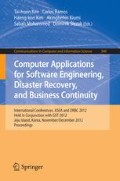Abstract
When disasters occur, data for damage is been collected through media such as the internet, smart-phones, telephones of government-related organizations and some civilians. However, an integrated system to accumulate and to manage the damage data is not completely constructed, and current disaster management systems have disadvantage sin regards to accuracy and cost in constructing spatial databases because of batch input processing with related documentations. We integrate dispersed data into our designed spatial database, such as photos transferred from smart-phones by civilians and other related information. We have developed an integrated damage spatial data management system to generate polygon type of damage areas based on the existing disaster history management system. In this system, managers can conveniently indicate damage areas with three different forms based on maps. General users and managers can provide the collected damage information and can search disaster history information.
Access this chapter
Tax calculation will be finalised at checkout
Purchases are for personal use only
Preview
Unable to display preview. Download preview PDF.
References
Hristidis, V., Che, S., Li, T., Luis, S., Deng, Y.: Survey of Data Management and Analysis in Disaster Situations. The Journal of Systems and Software 83, 1701–1714 (2010)
Lee, J.K., Niko, D.L., Hwang, H.S., Park, M.G., Kim, C.S.: A GIS-based Design for a Smartphone Disaster Information Service Application. In: 1st ACIS/JNU International Conference on Computers, Networks, Systems, and Industrial Engineering, pp. 338–341. IEEE Computer Society (2011)
Shibayama, A., Hisada, Y., Mirakami, M., Endo, M., Zama, S., Takizawa, O., Hosokawa, M., Ichii, T.: A Study on the Disaster Information Collection Support System, Incorporating Information and Communication Technology. In: 14th World Conference on Earthquake Engineering, pp. 1–8 (2008)
Lwin, K.K., Murayama, Y.: Web-based GIS System for Real-Time Field Data Collection Using a Personal Mobile Phone. Journal of Geographic Information System 3, 382–389 (2011)
Kim, G.R.: Methodology for the management and application of flood plain maps using cadastral information, master’sthesis, pp. 1–87 (2007)
Kim, T.H., Kim, K.H., Nam, G.B., Shim, J.H., Choi, W.J., Cho, M.H.: Development of Natural Disaster Damage Investigation System using High Resolution Spatial Images. Korean Spatial Information System Association 12(1), 57–65 (2010)
Niko, D.L., Hwang, H.S., Lee, Y.G., Kim, C.S.: Integrating User-Generated Content and Spatial Data into Web GIS for Disaster History. In: Lee, R. (ed.) Computers,Networks, Systems, and Industrial Engineering 2011. SCI, vol. 365, pp. 245–255. Springer, Heidelberg (2011)
FEMA, National Flood Hazard Layer (NFHL) Web Map Service(WMS)-Add Flood Hazard Map Layers to Your GIS Applications (2008), http://msc.fema.gov
National Emergency Management Agency. A Guide to Construct Disaster Maps, No. 2006-6, pp. 1–78 (2006)
Abbas, S.H., Srivastava, R.K., Tiwari, R.P.: GIS-based Disaster Management: a Case Study for Allahabad Sadar Sub-district. Management of Environmental Quality: An International Journal 20(1), 33–51 (2009)
Jeon, T.G., Hwang, H.S., Kim, C.S.: A UIS-based System Development to Express the Damage History Information of Natural Disasters. Journal of Korea Multimedia Society 13(12), 1739–1747 (2010)
Kim, J.B.: Realization of Disaster Prevention System based on Open Source for Efficient Disaster Management, doctor dissertation, pp. 1–96 (2012)
Author information
Authors and Affiliations
Editor information
Editors and Affiliations
Rights and permissions
Copyright information
© 2012 Springer-Verlag Berlin Heidelberg
About this paper
Cite this paper
Hwang, H.S., Kim, C.S. (2012). A Study on Damage Spatial Data Generation to Construct Disaster History Information. In: Kim, Th., Ramos, C., Kim, Hk., Kiumi, A., Mohammed, S., Ślęzak, D. (eds) Computer Applications for Software Engineering, Disaster Recovery, and Business Continuity. Communications in Computer and Information Science, vol 340. Springer, Berlin, Heidelberg. https://doi.org/10.1007/978-3-642-35267-6_30
Download citation
DOI: https://doi.org/10.1007/978-3-642-35267-6_30
Publisher Name: Springer, Berlin, Heidelberg
Print ISBN: 978-3-642-35266-9
Online ISBN: 978-3-642-35267-6
eBook Packages: Computer ScienceComputer Science (R0)

